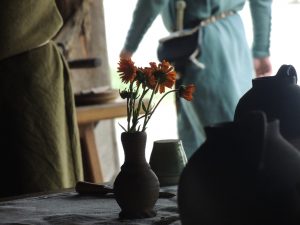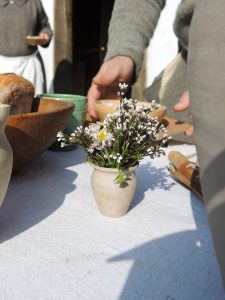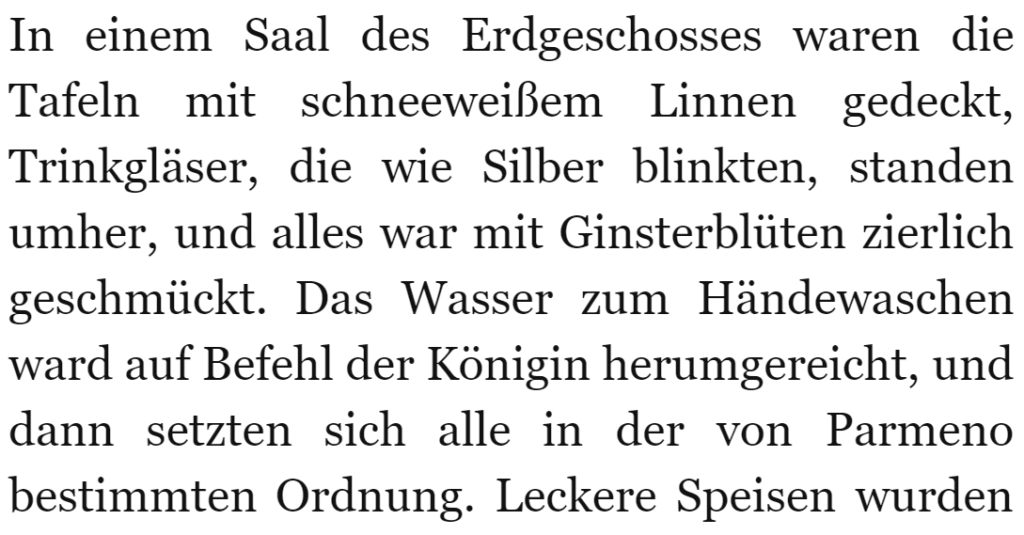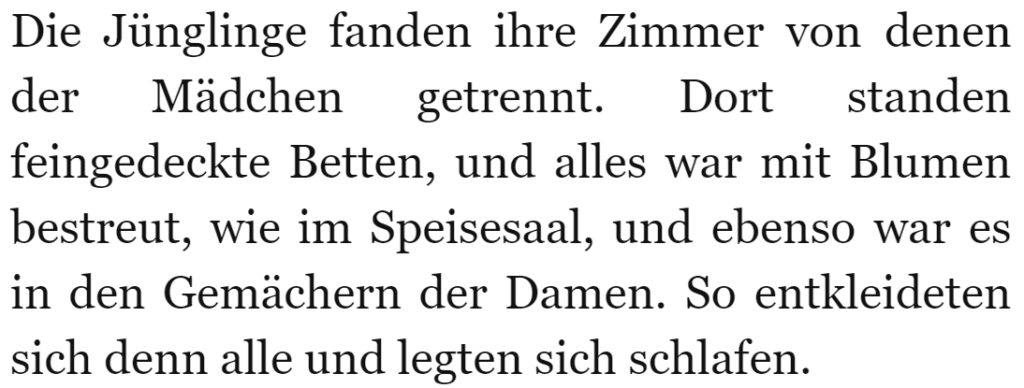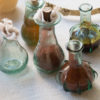Blumenvasen am Tisch ja oder nein?
Darstellung und Belebung bedeutet, alles zu hinterfragen, was man im modernen Leben für selbstverständlich hält. Auch zB ob solche hübschen Blumenvasen am Tisch eigentlich auch dem mittelalterlichen Menschen gefallen hätten?
Sehen wir mal nach!
Die Quellenlage fürs 14te ist leider sehr spärlich, aber da:
Um 1340-50, Maigen Österreich, Filialkirche St. Johannes der Täufer
Duccio di Buoninsegna, Altar in Siena
Und noch mal Italien im 14ten, ein Blumenkisterl
Fürs 15te siehts da schon wesentlich besser aus:
Maria am Gestade Altar um 1460
Nochmal Meister der Maria am Gestade
Und hier noch mal eine hübsche Sammlung
Und hier noch was aus Österreich, Fresko des Hl. Augustinus im Kreise hl. Jungfrauen, 1415
Ein Blumengeschmücktes Bett um 1470
Leider wird in keinem der Bilder der Zusammenhang mit dem gedeckten Essenstisch gezeigt. Obwohl es nun doch so einige Tischszenen in Abbildungen gibt, überwiegen in Abbildungen Tischzierden mit praktischem Nutzen. Hübsche Tischtücher, teure Kerzenleuchter, Aquamanilen, feines Zinngeschirr und zarte Gläser lassen sich dagegen häufig finden.
Im folgenden sammle ich noch weiter Belege, die ich hier ergänze:
ZB im Decamerone (14tes) zu einem festlichen Essen:
Und im Menagier de Paris heißt es einmal über eine Wiedersehensfeier:
„Als seine Frau eine Tagesreise von Paris entfernt war, schmückte er sein Haus mit Zweigen und grünem Blattwerk und versammelte seine Freunde, dass sie mitkämen, um sie zu treffen.“
Aus einer Predigt des 14. Jahrhunderts (Edition von Hermann Leyser) stammt dieser Text:
„...wenn ein König erschiene, ein igelich menfche bedeckete daz erdriche mit rofen und mit bluomen duorch den guoten ruoch, er behinge die wende mit ruckelachen.“
Von Jim Chevallier in Medieval food before the crusades
„Apollinaris describes a magnificent table at the end of the Gallo-Roman period: „Crown it with laurel, ivy and green vine shoots. Flowers of laburnum, saffron, and starword, rosemary, privet, marigolds, fill large baskets and with your fragrant garlands cover the armoires and couches.“But he also mentions “pails [no doubt of beer] crowned with fragrant garlands” at a Frankish wedding.
Under the Franks, Fortunatus, an Italian living in the Gallo-Roman milieu of the Church, presented an exuberant image of the flowered dining room:“Happy guest, see these delicious preparations which tempt by their good odor, before being prized for their taste; see this quantity of brilliant flowers which smile agreeably. The countryside barely offers as many roses as this table. The milk white lily stands out against a purple background, the ones contend with the others to embalm this place with their fresh scents. It is on this ground that drips with dew that these dishes are presented. Why do roses cover what the tablecloth usually does? It is that a table with no cloth, but with varied and scented flowers in its place, must please all the more. On the wall bedecked with garlands of ivy, one thinks to see the meadows grow green beneath the roof…“ https://gallica.bnf.fr/ark:/12148/bpt6k1115054/f264.item.r=%22vi
Charlemagne’s biographer, Einhard, describes a bishop’s feast where „every kind of choice drink, subtly and variously compounded, was offered them in bowls of gold and gems, whose sheen was mixed with that of the flowers and leaves with which they were crowned„.“
Und hier findet sich noch eine Erwähnung von bestellten Blumen für ein gemeinsames Essen durch den Duc d‘ Anjou 1379
Ein Portrait eines Ehepaares aus dem 15ten Jahrhundert
Ein Artikel zu Blumen- und Blätterdekoration bei mittelalterlichen Festtagen
The Culture of Flowers, Jack Goody
Verwandte Beiträge
Die folgenden Beiträge könnten Sie ebenfalls interessieren:




